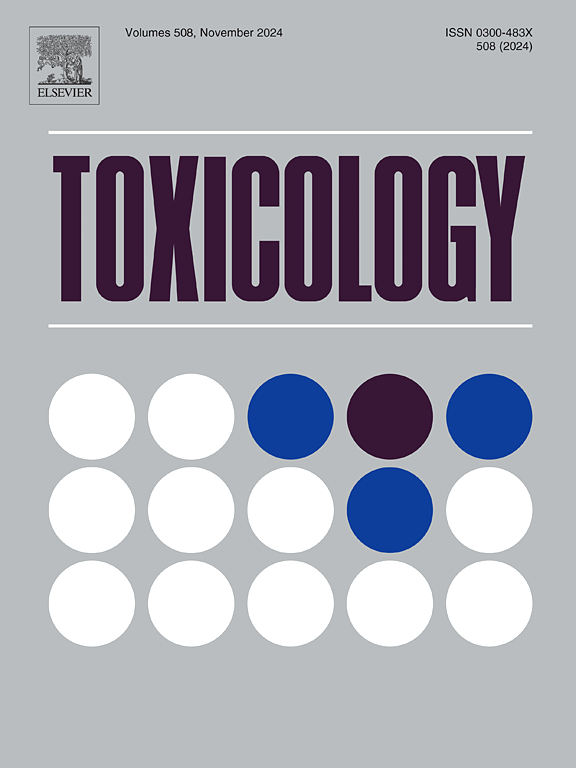Peritubular myoid cells of the testis produce monocyte chemotactic protein 1 upon direct exposure to Mono-(2-Ethylhexyl) phthalate through the IL-1 signaling pathway
IF 4.8
3区 医学
Q1 PHARMACOLOGY & PHARMACY
引用次数: 0
Abstract
Mono-(2-ethylhexyl) phthalate (MEHP) is a metabolite of the diester parent compound Di(2-ethylhexyl) phthalate (DEHP), a widespread environmental toxicant known for its harmful effects on Sertoli cells and the subsequent loss of germ cells through apoptosis in postnatal animals. Peritubular myoid cells (PTMCs) produce various signaling factors, including the chemokine monocyte chemotactic protein 1 (MCP-1); however, the MEHP exposure-induced BTB disruption followed by MCP-1 secretion by PTMCs, the recruitment, and activation of macrophages as well as molecular mechanisms that initiate the secretion in the testis has yet to be closely examined. In this study, we demonstrate for the first time that PTMCs generate MCP-1 via the interleukin-1 signaling pathway upon MEHP exposure. Primary PTMCs isolated from the testis of peripubertal rats were cultured and exposed to 100 μM and 200 µM MEHP. Total RNA was used for bulk RNA sequencing, qRT-PCR, and protein lysates for proteomic analysis. Testis and their interstitial fluid (IF) were obtained from MEHP-exposed animals to evaluate the levels of pro-inflammatory cytokines and chemokines in IF through a multiplex assay and in tissue sections through immunofluorescence studies. The RNA sequencing data show significant enrichment of the interleukin-1 signaling pathway after MEHP (200 µM) exposure for 48 hours. This finding is further supported by the qRT-PCR results for select genes associated with the IL-1 signaling pathway, highlighting the crucial role of this pathway in the response of PTMCs to MEHP exposure. In summary, MEHP exposure stimulates MCP-1 production by PTMCs, and mechanistically, the IL-1 signal transduction pathway governs this response. Keywords: MCP-1, PTMCs, Rats, Testis, Chemokine, IL-1 signaling
直接暴露于邻苯二甲酸单-(2-乙基己基)后,睾丸小管周围肌样细胞通过IL-1信号通路产生单核细胞趋化蛋白1。
邻苯二甲酸一(2-乙基己基)酯(MEHP)是二酯母体化合物邻苯二甲酸二(2-乙基己基)酯(DEHP)的代谢物,二(2-乙基己基)邻苯二甲酸二酯(DEHP)是一种广泛存在的环境毒物,因其对支持细胞的有害影响而闻名,并在出生后动物中通过凋亡导致生殖细胞的损失。管周肌样细胞(PTMCs)产生多种信号因子,包括趋化因子单核细胞趋化蛋白1 (MCP-1);然而,MEHP暴露诱导BTB破坏,随后ptmc分泌MCP-1,巨噬细胞的募集和激活以及启动睾丸分泌MCP-1的分子机制尚未得到仔细研究。在这项研究中,我们首次证明在MEHP暴露后,ptmc通过白细胞介素-1信号通路产生MCP-1。培养从青春期大鼠睾丸中分离的原代ptmc,分别暴露于100 μM和200µM MEHP中。总RNA用于大宗RNA测序,qRT-PCR,蛋白质裂解物用于蛋白质组学分析。从mehp暴露的动物身上获得睾丸及其间质液(IF),通过多重试验和组织切片免疫荧光研究评估IF中促炎细胞因子和趋化因子的水平。RNA测序数据显示,MEHP(200µM)暴露48小时后,白细胞介素-1信号通路显著富集。这一发现进一步得到了与IL-1信号通路相关基因的qRT-PCR结果的支持,强调了该通路在ptmc对MEHP暴露的反应中的关键作用。综上所述,MEHP暴露刺激ptmc产生MCP-1,而在机制上,IL-1信号转导通路控制着这一反应。关键词:MCP-1, PTMCs,大鼠,睾丸,趋化因子,IL-1信号传导
本文章由计算机程序翻译,如有差异,请以英文原文为准。
求助全文
约1分钟内获得全文
求助全文
来源期刊

Toxicology
医学-毒理学
CiteScore
7.80
自引率
4.40%
发文量
222
审稿时长
23 days
期刊介绍:
Toxicology is an international, peer-reviewed journal that publishes only the highest quality original scientific research and critical reviews describing hypothesis-based investigations into mechanisms of toxicity associated with exposures to xenobiotic chemicals, particularly as it relates to human health. In this respect "mechanisms" is defined on both the macro (e.g. physiological, biological, kinetic, species, sex, etc.) and molecular (genomic, transcriptomic, metabolic, etc.) scale. Emphasis is placed on findings that identify novel hazards and that can be extrapolated to exposures and mechanisms that are relevant to estimating human risk. Toxicology also publishes brief communications, personal commentaries and opinion articles, as well as concise expert reviews on contemporary topics. All research and review articles published in Toxicology are subject to rigorous peer review. Authors are asked to contact the Editor-in-Chief prior to submitting review articles or commentaries for consideration for publication in Toxicology.
 求助内容:
求助内容: 应助结果提醒方式:
应助结果提醒方式:


